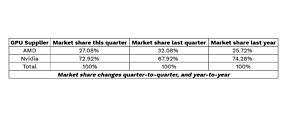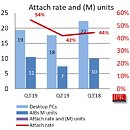Raevenlord
News Editor
- Joined
- Aug 12, 2016
- Messages
- 3,755 (1.21/day)
- Location
- Portugal
| System Name | The Ryzening |
|---|---|
| Processor | AMD Ryzen 9 5900X |
| Motherboard | MSI X570 MAG TOMAHAWK |
| Cooling | Lian Li Galahad 360mm AIO |
| Memory | 32 GB G.Skill Trident Z F4-3733 (4x 8 GB) |
| Video Card(s) | Gigabyte RTX 3070 Ti |
| Storage | Boot: Transcend MTE220S 2TB, Kintson A2000 1TB, Seagate Firewolf Pro 14 TB |
| Display(s) | Acer Nitro VG270UP (1440p 144 Hz IPS) |
| Case | Lian Li O11DX Dynamic White |
| Audio Device(s) | iFi Audio Zen DAC |
| Power Supply | Seasonic Focus+ 750 W |
| Mouse | Cooler Master Masterkeys Lite L |
| Keyboard | Cooler Master Masterkeys Lite L |
| Software | Windows 10 x64 |
The add-in board market increased in Q3'19 by 42% from last quarter, with over $2.8 billion dollars of AIBs shipped. Nvidia increased its market share to 73% in Q3. The last fiscal quarter was transitional for Nvidia as older products made their way through the channel allowing the company to ramp up production and ship more new products at the end of the quarter. Nvidia not only boosted their market share but they raised the overall AIB market. Their channel inventory is now reported as healthy says the company. Nvidia's RTX line is doing well and represents 66% of its gaming revenue.
Quarter-to-quarter graphics add-in board shipments increased by 42.2% and increased by 6.2% year-to-year. The market shares for the desktop discrete GPU suppliers shifted in the quarter, Nvidia significantly increased market share from last quarter, while AMD increased share year-over-year.

Add-in boards (AIBs) using discrete GPUs are found in desktop PCs, workstations, servers, rendering and mining farms, and other devices such as scientific instruments. They are sold directly to customers as aftermarket products or are factory installed by OEMs. In all cases, AIBs represent the higher end of the graphics industry with their discrete chips and dedicated, often large, high-speed memory. Systems with integrated GPUs in CPUs share slower system memory.
The PC AIB market now has just two chip (GPU) suppliers which also build and sell AIBs. The primary suppliers of GPUs are AMD and Nvidia. There are 54 AIB suppliers. They are the AIB OEM customers of the two major GPU suppliers, which they call partners. Some of the AIB suppliers offer AMD and Nvidia-based products, and others offer only one or the other.
In addition to privately branded AIBs offered worldwide, about a dozen PC suppliers offer AIBs as part of a system, and/or as an option, and some offer AIBs as separate aftermarket products. We have been tracking quarterly AIB shipments since 1987—the volume of those boards peaked in 1999, reaching 114 million units when every PC had a graphics AIB in them. This quarter 10.5 million AIBs shipped.
The AIB market hit $15 billion last year and is forecasted to be $15 billion by 2023.
Since 1981, 1,299 million AIBs have been shipped.
The third quarter is normally the strongest from the previous quarter. This quarter it was up 42.2% from the last quarter. That is above the ten-year average of 14.9% which is unusually high when compared to the desktop PC market, which increased 9.6% from the last quarter.

On a year-to-year basis, we found that total AIB shipments during the quarter rose 6.2%, which is greater than desktop PCs, which fell -15.9% from the same quarter a year ago. Overall, AIBs shipments had been declining slightly, but not as great as the PC due to gaming. However, in 2015 when the use of AIB for cryptocurrency mining became widespread, AIB sales started to rise while PC sales fell.
Despite the overall PC churn, somewhat due to tablets and embedded graphics, the PC gaming momentum continues to build and is the bright spot in the AIB market. The impact and influence of eSports has also contributed to market growth and has attracted new users. VR continues to be interesting but is not having a measurable influence on the AIB market.
View at TechPowerUp Main Site
Quarter-to-quarter graphics add-in board shipments increased by 42.2% and increased by 6.2% year-to-year. The market shares for the desktop discrete GPU suppliers shifted in the quarter, Nvidia significantly increased market share from last quarter, while AMD increased share year-over-year.

Add-in boards (AIBs) using discrete GPUs are found in desktop PCs, workstations, servers, rendering and mining farms, and other devices such as scientific instruments. They are sold directly to customers as aftermarket products or are factory installed by OEMs. In all cases, AIBs represent the higher end of the graphics industry with their discrete chips and dedicated, often large, high-speed memory. Systems with integrated GPUs in CPUs share slower system memory.
The PC AIB market now has just two chip (GPU) suppliers which also build and sell AIBs. The primary suppliers of GPUs are AMD and Nvidia. There are 54 AIB suppliers. They are the AIB OEM customers of the two major GPU suppliers, which they call partners. Some of the AIB suppliers offer AMD and Nvidia-based products, and others offer only one or the other.
In addition to privately branded AIBs offered worldwide, about a dozen PC suppliers offer AIBs as part of a system, and/or as an option, and some offer AIBs as separate aftermarket products. We have been tracking quarterly AIB shipments since 1987—the volume of those boards peaked in 1999, reaching 114 million units when every PC had a graphics AIB in them. This quarter 10.5 million AIBs shipped.
The AIB market hit $15 billion last year and is forecasted to be $15 billion by 2023.
Since 1981, 1,299 million AIBs have been shipped.
The third quarter is normally the strongest from the previous quarter. This quarter it was up 42.2% from the last quarter. That is above the ten-year average of 14.9% which is unusually high when compared to the desktop PC market, which increased 9.6% from the last quarter.

On a year-to-year basis, we found that total AIB shipments during the quarter rose 6.2%, which is greater than desktop PCs, which fell -15.9% from the same quarter a year ago. Overall, AIBs shipments had been declining slightly, but not as great as the PC due to gaming. However, in 2015 when the use of AIB for cryptocurrency mining became widespread, AIB sales started to rise while PC sales fell.
Despite the overall PC churn, somewhat due to tablets and embedded graphics, the PC gaming momentum continues to build and is the bright spot in the AIB market. The impact and influence of eSports has also contributed to market growth and has attracted new users. VR continues to be interesting but is not having a measurable influence on the AIB market.
View at TechPowerUp Main Site





